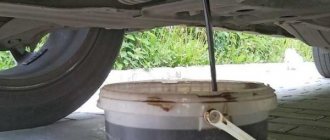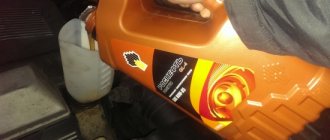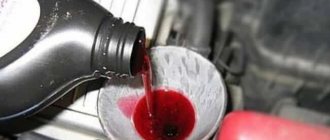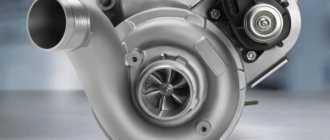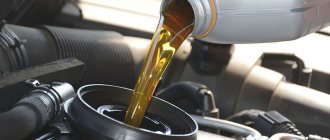Micropump for changing oil with clean hands: putting it to the test
Changing the oil is one of the most basic procedures in car maintenance yourself, but it is far from the most pleasant. You can make it simple and comfortable with the help of a simple gadget for nominal money. Let's check how an interesting technical solution works, allowing everyone to change the oil in ten minutes without a garage, without a pit, and without even changing into work clothes!
Needless to say...
On the website of a popular Chinese online store, in the description of a 12-volt water pump for arranging fountains in aquariums and country decorative mini-pools, we accidentally came across an interesting review from a Russian car owner who used this pump as a system for pumping oil out of the crankcase of his Fiat engine. Bravo!
The pump is designed for water, but the cunning citizen quickly realized that if you connect thin hoses and wires with a pair of alligator clips to it to power the device from a car battery, you will get an ultra-low-cost system for changing the oil in an engine or gearbox! Similar pumps complete with tubes and wires, designated as specialized for pumping out oil, cost from 2,000 rubles or more in a Chinese online store, so in this case it turns out to be an extremely economical option.
This solution, of course, is not relevant for everyone - after all, what is the use of pumping out oil through the dipstick if you still need to crawl under the “belly” of the car in order to unscrew the filter? However, there are quite a lot of cars in which the modification of the engine and the layout of the engine compartment make it possible to easily unscrew the oil filter from above from under the hood: from the Granta to the Focus and from the “Volgov” old man ZMZ-402 to the “Skoda” 1.2 MPI with replaceable paper elements in glasses. Well, there are some unique ones - Volkswagen engines CAXA, CFNA, etc., in which the filter is located almost vertically at the level of the block head, as a result of which unscrewing it is even easier than adding water to the washer reservoir. Plus, the filter is removed completely clean and empty, without a drop of oil.
Let's check how convenient and feasible the proposed solution is? Our goal is to determine the efficiency of the pump, whether the performance is sufficient when working with thick oil instead of water, and most importantly, how durable is its design? After all, if in the interval between oil changes the waste residues in the pump destroy its plastic from the inside, then there is no point in such “handjob”...
Pump design
The design of the pump surprised and upset me. There was a feeling that the cunning citizen who threw the idea into the masses did not disassemble it before using it as an “oil pump”... The principle of operation of the Chinese craft is almost the same as that of high-pressure pumps of washing installations “a la Karcher”, but not on based on metal plungers-pistons, and on the basis of silicone elastic membranes. An eccentric is installed on the electric motor shaft, which, rotating, alternately lifts the pumping membranes arranged in a circle. One-way flow of liquid is ensured by check valves made of the same transparent silicone.
Let's pump the oil!
To pump oil through the dipstick hole, you will have to select a suitable plastic tube. This task is not to say difficult, but, to some extent, creative. The tube must fit into a narrow hole and have thin enough walls so as not to resist the flow of oil. In our case, we came across a Russian-made television antenna cable, from the shell of which we pulled out the central core and inner braid, holding the tail in a vice.
A real experiment confirmed the efficiency of the pump - approximately three and a half liters of oil from the WV Polo engine are vigorously pumped out in about five to six minutes; The motor heats up during this time, but not critically. A test unscrewing of the oil pan plug showed that no more than half a glass of oil was not sucked out. In general, a non-critical amount, which can also be reduced by splashing 200 grams of pure fresh oil into the oil filler neck after bubbles come out of the pump.
Is the pump durable?
Leaving the pump in an uncleaned state after changing the oil is fraught with danger. Lubricant can corrode or dissolve the rubber filling of the pumping unit while you roll back 10,000 km, waiting for the next replacement... Therefore, we carried out a control measurement of the pump’s performance on water (which showed that the pump pumps three liters of water in about two minutes), after which washed it thoroughly and measured its performance again after a month to make sure it had not deteriorated and its efficiency had not decreased.
Cleaning the pump from oil from the description may seem like a chore, but in fact it is very simple and took no more than five minutes in total - you won’t even get your hands dirty. First, we lowered the suction and outlet hoses of the pump into a jar with about one hundred grams of gasoline and ran it in a circle. The pump spun the gasoline for a couple of minutes, washing out the remaining oil. After which it was lowered into a similar container, in which a couple of tablespoons of detergent were added to two hundred grams of water. And the pump also drove this liquid in a circle for a minute or two - at this point the cleaning was completed. Perhaps it would be more correct to disassemble the pump, but removing the membranes (and then inserting them back!) is quite difficult, and in this case the whole idea becomes meaningless...
Briefly about the essence of the procedure
I don’t see any point in describing in detail what express replacement is and how it is performed using certain devices of different professional levels.
Do-it-yourself plastic bumper repair: video instructions
Category: DIY repairs
I will try to briefly describe what a quick replacement is, how it differs and why this service is so often used by, let me say, lazy car owners who do not have the time or desire to fully remove old used motor oil. This is, of course, easier when at least 10 points work next to me. To be honest, I once thought about express replacement as a business idea. But soon he quickly said goodbye to her. This is an illiquid service that costs 300-500 rubles. Earnings come from others. Moreover, you will learn about this in the section about the disadvantages of this method.
Well, let's take a look at the essence of express replacement. The liquid in the form of old motor oil does not drain through a special hole, which is provided on the bottom of the crankcase on all machines.
A different approach is used for draining. Namely through the dipstick. In fact, the oil is not drained, but rather sucked out of the engine. First, the probe is simply removed and a tube is inserted into the hole formed. At the other end of this tube there is a pump and a container in which all the sucked liquid is collected. If the tube reaches the bottom of the engine crankcase, there are no particular complaints about the hardware replacement, since under such conditions it is possible to efficiently remove the old oil sediment. But the design of many engines does not allow for express replacement to reach the place where dangerous mining deposits accumulate.
The method looks quite interesting and promising. After all, it turns out that the car does not need to be lifted with a lift, on an overpass or climbed under it, which requires an additional inspection hole. The tube from the oil suction apparatus is inserted into the hole of the dipstick and the lubricant is removed using special equipment. Then all that remains is to change the old oil filter, fill in new oil such as Liqui Moly, and that’s it, the car is ready for further use. The manipulations are extremely fast and simple, which explains the name of the express replacement.
But this only at first glance seems so convenient and promising. In fact, despite the obvious advantages, a quick oil change also has its serious disadvantages. We'll talk about the pros and cons separately.
Main advantages
I’ll slightly whet your interest in the most important part of the article, and first I’ll suggest you look at the strengths of express engine oil change in a car engine.
The strengths of draining waste through the dipstick are as follows:
How does the ERA GLONASS button work on a car and why is it needed at all?
Category: Instructions
- Low price for services provided. Using the express method to pump out oil is not only quick, but also quite cheap. Although there may be additional costs involved;
- Save time. Despite the need to visit a service station where the appropriate equipment is available, draining and changing the fluid takes a minimum of time;
- No need to crawl under the car. Simply lift the hood, remove the dipstick, and pumping begins. Filling is done traditionally through the filler hole;
- The oil does not spill anywhere, does not spill onto your clothes or onto the floor;
- A professional method that involves the participation of experienced specialists in the process;
- There is no need to get rid of working off yourself.
That's all with the advantages. If you know any other strengths, write in the comments.
Key Disadvantages
I would like to remind you that express replacement also has other names. This is a vacuum and hardware replacement. But the name doesn’t change the essence.
Now it is important to focus on what disadvantages this method has and what the danger is.
One of the disadvantages is the difficulty of performing an express replacement with your own hands. Self-pumping is possible, but for this you will have to buy a special device costing about 10-15 thousand rubles minimum. For an ordinary car owner, these are completely meaningless, unjustified costs.
But I want to focus on the main drawback. Since pumping is carried out through the hole in the dipstick, the tube does not reach the bottom of the engine crankcase. What does this mean? It's simple. It is at the bottom that sediment, waste, particles of metal shavings and all those components settle that, when circulating through the lubrication system, cause damage to the engine. It is because of this sediment that it is extremely important to change the engine oil on time, otherwise rapid wear of parts simply cannot be avoided. Repeated replacement using exclusively the express method leads to the fact that the amount of sediment and metal shavings, along with other components of used oil, grows rapidly. And this is a direct threat to the integrity of the engine. You can find many visual videos online that demonstrate the consequences of incorrect oil changes.
No, express replacement has a right to exist. But only with the right approach. Experts advise alternating a quick replacement with a complete one, when all the fluid is drained, up to removing the oil pan and mechanically removing all contaminants. After serious cleaning, it is possible to change the oil using the hardware method as part of the next maintenance. But then you need to completely drain the waste through the drain hole again. At approximately every 2-3 scheduled replacement, it is a good idea to flush the engine. For this purpose, special flushing oils are used, which you can learn more about in the material at the link.
In addition to the underlying danger, there is also a risk of encountering unscrupulous service station employees. They begin to look for non-existent problems, drop oil on the engine unnoticed by you, focusing attention on the fact that your oil seals are leaking or other problems have arisen in the oil system. Plus, the expensive oil you bought can be replaced with a cheap one. There are many tricks and tricks.
We recommend: Which is better, a turbocharged or naturally aspirated engine?
You can draw the final conclusions yourself. Share your opinion in the comments and leave feedback. Thanks everyone for your attention!
Thanks for reading! Please rate the article
( 1 ratings, average: 5.00 out of 5)
Loading…
Why is it necessary to change the oil through a hole?
The purpose of the devices we tested often causes confusion. Why, they say, invent some perverted ways of changing oil through a dipstick tube that is not intended for this at all? After all, there are special drain holes provided by car designers.
Meanwhile, there is a justification. A classic engine oil change involves the use of a lift or overpass: in the twenty-first century, you shouldn’t climb under a car! The service station has all this, but at the dacha or even in the garage this is not always the case.
But if the oil filter on your car is accessible from above, then the devices in question will help you change the oil without diving under the car. In addition, it makes sense to use them during intermediate oil changes, when changing the oil filter is not necessary. Finally, such devices will be useful for those who use not only a car, but also a boat, in which the engine sump is located very close to the bottom.
Our expertise includes three different types of devices: syringe, vacuum and electric pumps. It is important that vacuum devices suck the oil inside without the need for a container for the waste product. But electric and syringe devices cannot do without an additional bucket.
Advantages and disadvantages of different oil change methods
Traditional way
Advantages:
- The maximum possible amount of old oil is drained, since the plug is located in the lower part of the crankcase;
- Along with the exhaust, dirt, slag and deposits that did not enter the oil filter are removed;
- More precise control over the volume of mining;
- It is possible to simultaneously inspect the lower part of the engine, suspension elements, etc., since you are still under the bottom.
- The oil change process follows the instructions for performing routine maintenance.
Traditional oil change method
We recommend: Engine lubrication system. General structure and principle of operation
Flaws:
- More time is wasted;
- A pit, overpass or lift is required;
- The process is messier.
Express replacement
Advantages:
- Replacement is done quickly;
- The waste gets into the tank without possible contact with hands, without spilling on the floor or splashing.
- There is no need for an overpass or hole;
- The aesthetics of the process are top notch.
Flaws:
- It is impossible to pump out 100% of the waste material - the tube will not always reach the bottom point;
- There is no possibility of visual inspection of the tube inside the crankcase;
- Dirt, deposits, and slag remain at the bottom of the crankcase and mix with fresh oil;
- There is a risk of damage to the internal parts of the engine by the tube, it may break off and then the crankcase will have to be removed for removal.
- If the oil filter is accessible only from under the bottom, there is no point in express replacement; you will still need a lift or a pit.
What did they check?
The main requirement for such products is ease of use. We had to measure the sizes of the hoses, evaluate their heat resistance (after all, oil can be hot!), measure the vacuum and measure the time required to pump out a fixed volume of liquid using the example of 0W‑40 oil heated to 60˚C.
As usual, during the tests many features emerged that you might not think about at first. So, all three syringes turned out to be equipped with thick hoses that would never fit into the hole in the oil level meter tube. Why was it necessary to announce the possibility of pumping oil out of the engine? To use such syringes, you will have to do a little farming, selecting a tube of the desired diameter.
That's not all. The volume of the syringe cannot be fully realized due to the parasitic volume of the suction hose. What volume exactly? And it depends on you. More precisely, it depends on what hose you choose! In this case, it is very important to check its heat resistance in hot, or better yet, boiling water. When trying to pick up something similar from the means at hand, we ran into a hose that, when heated, shortened three times and, most importantly, tripled in diameter! How so? Why do we need such a plug for the probe hole? After all, it will be very difficult to remove it, and part of it may remain in the engine sump.
These devices will help you change engine oil without diving under the car
Aluminum body, good valves, comfortable handle, high vacuum, large diameter hoses. But for some reason the oil suction hose is not included in the kit.
Verdict: Useless without the right hose
Steel body. The quality of the inner surface of the pipe is low, which affects the magnitude of the vacuum. The top cover is screwed on with just one turn of thread. Hoses suitable for oil suction are not included in the kit.
Verdict: not recommended
Aluminum body, good valves, comfortable handle, high vacuum, large diameter hoses. There is no oil suction hose.
Verdict: without a hose - semi-finished product
The most expensive device in our sample is close in size to professional equipment. The tank can hold 9 liters of oil. Vacuuming is carried out manually using a pump. The high vacuum allows you to free your hands after pumping and direct the hose into the pan to drain the oil. But the adapter bushings between the hose and the container plug turned out to be from a different set. I had to make my own...
Verdict: works great!
The spherical chamber has a capacity of 6 liters. On top is a vacuum pump. Pumping is through a metal hose with a plastic braid (Bowden cable sheath). Therefore the cross section is small. It takes a long time to pump out, but does not require much effort.
Verdict: quite working pump
It is powered by a car battery with a twisted cable about 1.8 m long with crocodile clips. But even after wetting the gears, the vacuum created by the pump did not exceed 10 mm of mercury. The product refused to pump oil. During disassembly, no damage was found, but the combination of large gaps and poor workmanship led to the failure of the pump. Even if there is pure oil at the inlet, something gray in color, as if with graphite, is spit out at the outlet.
Verdict: not worth buying
It is powered by a twisted cable about 2.25 m long with crocodile clips from the car battery. After wetting the pump gears, the device provided good self-priming.
Verdict: you can use it
Our recommendations
- Performance with manual syringes depends on physical strength and patience. It is quite tiring to hold the smooth cylinder with one hand and pull the piston rod with all your might with the other. Therefore, the pumping time is approximate. By the way, you need to work with thick gloves: after all, when hot oil hits the syringe body, it instantly heats up.
- Electric pumps must first be moistened with a small amount of oil. Without this, their self-absorption is insufficient: no more than 10 mm Hg. But if you put just a little bit of any oil there, the pump will create a sufficient vacuum.
- We do not recommend syringe products for pumping out oil: there are no hoses and they are inconvenient to use.
- Of the electrical products, only SAMP 2 GS9222 performed well.
- Vacuum pumps with chambers for accumulating oil are driven by muscle force, but the forces are not as great as in syringes. You can create a vacuum reserve and move the end of the hose in the pan to better remove residual oil. Both vacuum devices performed well. At the same time, “Mastak” has a smaller safety margin of parts than its column-like competitor. But it is easier to place the “ball” somewhere in the corner of the balcony.
The results of our examination relate to a specific sample of products and cannot serve as a basis for judgments about all products of the same name.
Oil change pumps: “Behind the wheel” choice
Replacing and pumping oil through the dipstick - methods, pumps
Changing the oil in a car engine is perhaps a routine task, but it is a necessary procedure if you want it to have a long service life. And everything would be fine, but there is a very dirty and labor-intensive process - draining the oil. We invite you to familiarize yourself with its clean and simple, even more effective alternative - pumping oil through the engine dipstick.
Why is draining oil a labor-intensive process? Because the drain plug is located on the engine sump, which is often hidden behind the engine protection, and to remove it you need to at least find a hole or overpass. We also add to this the fact that a situation may arise when the crankcase plug cannot be unscrewed (it was pulled during the last replacement, it became stuck, etc.). Even after unscrewing it, you do not become the king of the situation, because everything will be spoiled by a stream of hot oil, which sometimes even experienced car enthusiasts cannot catch, and spray oil on everything in the area.
Oil change methods
The technological process of changing the substance takes place in several stages:
- selection and purchase of filter, lubricant and flushing;
- draining the used composition;
- filling the flush and running the engine at idle speed for a certain time;
- flushing drain;
- filter replacement;
- pouring new product.
In addition to the classic method of changing the lubricant, there is also an express oil change. The difference is that in the first case a hole or overpass is required, since the oil is drained through the drain plug. A container for waste substances and a change of clothes are also required.
Express replacement is carried out through the dipstick hole. This requires special equipment. You can use professional systems that are designed for large volumes of pumped-out composition and are equipped with an electric compressor. You can also use units for home use or installations at small service stations. These are, as a rule, lightweight mobile devices that have a capacity designed to pump out a small amount of lubricant.
Express engine oil change has the following advantages:
- the procedure goes quite quickly;
- you can change the product even if you don’t have the key to the drain plug;
- there is no need to crawl under the car, all work is carried out simply with the hood open.
Among the disadvantages of the method, it is worth noting the risk of pumping out not all of the waste substance. You can also accidentally break the tube and leave it inside. It is important that only the most reliable express oil change equipment is used.
Pumping oil through the dipstick - basic methods
There are two main methods for pumping oil out of the engine through the dipstick - using a pump, using a syringe. There is also vacuum pumping, but this method is more complicated than the first two and is generally applicable in service conditions. We invite you to familiarize yourself with the methods that you can apply even in the parking lot in front of your house.
We warn you: these methods of draining engine oil do not have the same effect as draining oil through a plug. The plug is located at the lowest point of the crankcase, so the maximum amount of old oil is removed through it. The methods described in the article cope with this to a maximum of 95-98%. But this is not scary, because with every oil change, the oil filter is also changed, which will easily absorb all the crap that remains in the oil pan.
Also, before this method of changing the oil, the engine needs to be thoroughly warmed up - this way the oil will get maximum fluidity, which means it will drain through the dipstick as efficiently as possible.
Oil pumping process:
The tubes included in the kit did not fit into the hole for the dipstick; the tube from under the dropper helped.
If none of them fit, then why are all these tubes included? If you buy it, it’s better to have a separate pump, especially since it costs half as much.
Install:
connect (
the engine is warmed up, otherwise the oil will be thick and it will take even more time to pump out
):
After half an hour, approximately 2.5 liters were pumped out.
I think it pumps slowly due to the small diameter of the dropper, but larger diameter tubes do not fit into the hole for the dipstick.
Most
the main argument against changing engine oil through the dipstick
The problem is that when the engine operates, the oil wears out, and many of its additives, which are necessarily included in the composition, precipitate. All this sediment, including dirt and combustion products of additives, remains at the bottom. When changing the oil through the dipstick with your own hands, it is impossible to get all this sediment from the bottom, and even after the change it will lie there. By pouring in new oil, the old sediment will mix with the new one, and this will lead to the fact that the efficiency of the new oil will be reduced. It is quite logical that with each new pumping through the dipstick, the sediment will remain large, and ultimately this will seriously reduce the service life of the motor. Therefore, the conclusion is this: you can change the oil through the dipstick yourself, but you shouldn’t get carried away with it.
Pump for pumping oil through the dipstick
Pumping out the oil through the dipstick using a pump is the easiest way, because you actually don’t need to do anything.
What you will need: the pump itself, a power source and 2 tubes of the length and diameter you need.
We suggest using an electric pump - there are a lot of them on the market, you can even use washer pumps, and it’s extremely easy to power them using a car battery.
Two tubes will be needed to pump oil from the crankcase into the container - one intake, the other outlet. Here it is necessary to select based on the parameters of the pump fittings, the distance from the location of the pump to the bottom point of the crankcase, the distance from the pump to the container for testing.
There are also a lot of pumps themselves - we suggest using either diaphragm or rotary pumps. But here we have 2 ways - risky, a little fussy, but budget-friendly, and the second way with small investments. The choice is yours, but let us remind you of the wisdom - “the miser pays twice”
Draining oil with washer pump
This is the same budgetary, but labor-intensive and “dangerous” path. There are a lot of washer pumps - you want them from VAZ, you want them from GAZ, you want them from VAG. But remember - they are not designed for pumping oil, even when heated, which means they can fail at any time.
For example, let’s take the KALUGA ENTS2512 washer pump, which produces a power of 1.1 atmospheres and is powered by 12 Volts. Perfectly suits our conditions. You still need to buy tubes for it - you can take any, but it is better to choose oil- and gasoline-resistant ones, for obvious reasons. Another important parameter will be the internal diameter of the tube - it is 5 millimeters. In order not to deceive yourself, we take 4 meters of such a hose and cut it in half.
Then we need to somehow power this pump. On its body there are 2 male connectors - positive and negative. We buy (or get it by any other possible means) 2 female connectors, 2 wires and crocodiles. We also make sure to buy a syringe - any one, the main thing is that its nozzle fits the cross-section of the tube, it will be useful to us later. We put it all together and get a pump that can be powered from the battery. The main thing is not to confuse the polarity.
After you have decided through which fitting the pump draws liquid, connect the hoses, insert one into the dipstick body, and the other into a container for testing.
We turn it on and... nothing happens. Why? Because these pumps are unable to pick up oil and they need to be helped to take their first steps. This is where the syringe we bought earlier comes into play. When the pump is turned on, through the outlet tube (which goes into the drainage container), you need to pump out a little air from the pumping line - this way the pump will take the liquid and be able to work.
In addition to the materials required above, you should be patient - with this pump you will be pumping out oil for quite a long time, its performance is low. Well, of course, as we have already warned you, it can fail at any moment.
Oh yes, these VAZ crafts also love to leak, so don’t be surprised if something happens.
Pumping oil through the dipstick with an electric pump
You can spend a little money, but get a ready-to-use device. Again, there are a lot of options. Our favorite can be found on Aliexpress, the eternal rotary pump for pumping oil through a dipstick, which has a huge resource and is very easy to use.
The pump body is made of aluminum (it is quite heavy), there are two fittings on it for the intake and discharge of liquid - they are equipped with universal quick releases, that is, no mating connectors are needed, just insert the tube and the connection is ready!
Another important advantage is the jumper on the housing through which the pump power cable is routed. It is made in such a way that even if the pump falls, the wire will not be damaged.
The pump is powered by the same 12V using crocodiles, but already produces 0.3 MPa of pressure (this is almost 3 atmospheres, which is 3 times more than the washer pump). The kit includes 2 tubes of 3 meters each. In general, nothing else is needed - turn it on and off.
The price of such a pump is not small, but believe me, it is worth it.
View and buy
You can consider a cheaper option, but we personally cannot recommend it to you, since we have not used it. Also, if the first pump can pump out not only oil, but also fuel, oil from the automatic transmission, then this will not work, and its performance is less. And yes, you can buy it not only on Ali, but there it will cost much more.
Syringe for pumping oil through the dipstick
In the same way, you can pump out the oil through the dipstick using a syringe, but not a pharmaceutical one (Zhanet). No, they can do it too, but why bother and waste it drop by drop when there are inexpensive, professional and semi-professional solutions.
Such syringes are convenient and suitable for any type of technical fluid used in car components. The replacement procedure is exactly the same as when using an electric or vacuum pump.
Dear readers! If you have proven pumps, other methods of changing oil through a dipstick, suggestions or comments - we will be happy to read them in the comments! Also, we will be very grateful if you share this post with your friends on VKontakte , Odnoklassniki, Facebook, Twitter, and other social networks and Internet platforms.
Source
Your conditions
Engine oil loses its properties over time, so it must be changed every 10,000–15,000 km. The easiest way to do this is at a car service center, but you can also save money by doing the work yourself. For the lucky owners of a garage with an inspection hole, to drain the oil, you just need to unscrew the drain plug in the engine sump. Anyone who does not have access to such a hole can use a pump to pump out the oil through the dipstick hole.
Let us note right away: such a device will help you out only if you can reach the oil filter, the replacement of which is necessary when filling in new oil, from above. If in your car you can only replace the filter from the bottom, the oil pump will not make your job much easier. After all, you still have to crawl under the car.
Before you start
Secondly, the electric pump does not operate dry, so you need to remove the plugs on the holes for the tubes and pour 40–50 ml of oil into the device using a syringe.
Thirdly, the tube that goes into the oil dipstick hole has a diameter of 6 mm, while the diameter of the dipstick tube on some machines may be smaller in diameter. Simply put, not every engine can be connected to an electric pump. Among them, for example, is the 1.8-liter Lada Vesta engine, on which we initially wanted to do all the work.
Paradoxically, thanks to this, our experiment only became “cleaner”: we decided to drain the oil using an electric pump on the same car on which we tested the vacuum pumping installation some time ago. This is a Chevrolet Aveo.
Pure experiment
Insert the tube into the hole for the dipstick and connect it to the pump. On the other side we fix the second tube - to drain the oil. We lower its second end into a 5-liter plastic drinking water bottle (a transparent container allows you to control the volume of drained working fluid). We make sure that the pump is turned off, then connect the terminals of the device to the car battery, observing the polarity.
Turn on the pump and start pumping. The oil rises through a tube inserted into the dipstick hole, passes through the device and flows out of the second tube into a plastic container.
After a few minutes, the sound made by the oil pump motor changed as the engine became easier to operate. This means the oil has run out. Let's verify this by moving the tube inserted into the probe hole. If the sound of the pump does not change, turn off the device.
Examination
To understand how effectively the electric pump coped with its task, lift the car on a lift and unscrew the drain plug in the pan. The oil flows out quite intensively. During our last experiment, when we used a vacuum installation for similar work, this did not happen.
The conclusion is obvious: you should not change the engine oil yourself using an electric pump. And although the device is interesting, it clearly needs improvement.
Pumping out oil through the dipstick: the master clearly showed that this is not the best idea
I admit, 10,000 kilometers ago I had my engine oil changed using a pump that pumps waste out through the dipstick hole.
Then I perceived this as a very useful optimization of work. There is no need to lift the car, unscrew the protection, or lower it.
Moreover, the oil pump pumped out exactly as much oil as needed - 4.5 liters.
I arrived for another oil and filter change at a service I had never been to before.
This is a huge service for two dozen posts, where I was forced into one of the last posts with a young guy.
Next to the racks of tools there was also a pump for pumping out oil.
“Great!”, I thought. 15 minutes and I'll be gone.
But the master began to place lift legs under the car.
I asked why not a pump? To which I was offered a demonstration experiment.
They connected a pump to the car, removed the oil filter and began pumping out the oil. Literally three minutes and the pump flask contained the desired 4.5 liters of waste. The pump stopped pumping.
It seems like you can install a new filter and add oil.
But the master suggested continuing the experiment.
The car was raised on a lift, the protection was unscrewed, a basin was placed and the drain plug of the pan was unscrewed.
Another 200 grams of oil spilled out.
I won’t say that it was some kind of special liquid. But I won’t believe that it’s better than pumped out oil.
Most likely, the concentration of sediments in it was higher. According to the master, the pump is a good device. But if you use it, then alternately with draining the oil through the pan.
No pump will pump out the oil the way it drains through the lowest point in the sump.
And no one will argue with this fact.
In this matter it is better to be conservative and change the oil through the bottom.
Moreover, it is possible to inspect this very bottom once again.
What's left
We completely drained the oil from the engine, replaced the oil filter and filled it with fresh oil. The result of the experiment did not satisfy us - an impressive amount of old oil remained in the engine.
Despite the fact that an experiment with an electric pump cast doubt on the effectiveness of this device, it is possible to change the engine oil in a garage without an inspection hole. If you use a vacuum installation for this. It costs twice as much as an electric pump (2,600 rubles versus 1,300–1,350), but has two significant advantages over it: a vacuum unit, which pumps out the oil almost completely, is more efficient and versatile, since it allows it to be drained from the engine even through a narrow hole for the oil feeler gauge
Text: Tatiana Turbal
Send all questions and suggestions regarding the “Technical Environment” series of issues to Other issues of the “Technical Environment” are available in our special project, as well as on our YouTube channel.
What is an express oil change?
As noted above, during the standard oil change procedure, the used substance is drained through a hole in the lower part of the crankcase. During express replacement, it is removed through the hole into which the oil dipstick is inserted.
The express oil change process takes place only on a warm engine. This is due to the fact that oil heated to operating temperature has a lower viscosity, making it easier to pump out.
Important: An express oil change will not remove all the oil from the engine. If you do not bring the engine to operating temperature before starting work, you will be able to pump out even less oil due to its high viscosity.
When the engine reaches operating temperature, turn it off and remove the dipstick. A tube from a special oil pumping unit is placed in the hole for the oil dipstick. You need to insert the tube until it rests against the end.
Next, the pumping of oil into the installation begins. The installation itself is a device within which reduced pressure is created. Due to the low pressure in the device, oil begins to flow into it, being removed from the engine.
Please note: There are different installations for pumping out oil. Their main difference is the method of creating low pressure. This can be done manually or electrically.
After the maximum amount of oil has been removed from the engine, new oil is poured into it.

